Your Ultimate Guide to Sal Island – Travel Like a Pro (No Package Deals Needed)
Sal Island isn’t just your typical tourist trap. It’s the kind of place where you can get off the beaten path, live like a local, and still enjoy all the beauty this island has to offer—without booking a cookie-cutter package holiday. Here’s your guide to making the most of your time in this Cape Verde paradise.
Best Time to Visit Sal:
Let’s face it Europe and beyond can get a little gloomy in the winter months. That’s where Sal comes in. The best time to visit is between October and April, when Europe and elsewhere is stuck in chilly weather and Sal is basking in sun. Temperatures range from 20°C to 30°C, making it a perfect winter getaway. If you’re into local culture, don’t miss Festa de Nossa Senhora da Piedade in August, when the island comes alive with music, food, and celebrations.
Top Things to Do in Sal (That Aren’t Just Beach Relaxation):
Of course, you can lounge at the beach all day—Santa Maria’s white sands and crystal-clear waters are stunning. But Sal is more than just a sunbathing spot.
- Pedra de Lume Salt Mines: The salt mine is iconic, not just for history buffs but for anyone looking for a cool, Insta-worthy adventure. You can actually float in the salty waters—kind of like a mini Dead Sea experience!
- Buracona Lagoon: Known for the “Blue Eye,” a magical spot where the sun hits the water just right. It’s a bit of a trek to get there, but trust me, it’s worth it for those jaw-dropping views.
- Explore Espargos: The island’s capital has a more local, authentic vibe. Walk around, enjoy a coffee at a local café, or check out the markets for Cape Verdean crafts.
- Water Sports: Whether you’re into windsurfing, kitesurfing, or diving, Sal is a playground for ocean lovers. The island’s perfect winds make it a hotspot for kitesurfing.
Staying in Local Accommodations:
Now, here’s where things get interesting. You could book a package holiday at a big resort, but why not go local? Staying at locally-owned guesthouses, boutique hotels, or even private apartments gives you a much richer experience. Not to mention, it’s usually a lot more affordable.
- Cost of Accommodation:
Local accommodations typically range from €30–€90 per night. You can find a cozy guesthouse or budget-friendly apartment for around €40 per night. If you’re looking for something a bit more upscale, boutique hotels on the beach could be closer to €70–€100 per night. For a week, this will add up to anywhere from €210 to €700. - Why Go Local? You’re not just saving money—you’re also supporting the community. Locally owned businesses give you the chance to interact with the island’s warm-hearted people, discover hidden gems, and find experiences you’d never get with a package tour.
Meal Costs on Sal:
Eating out in Sal can be as affordable or luxurious as you make it, and there are options to suit every taste and budget.
- Street Food & Casual Dining: If you’re up for something casual, you can find tasty snacks and local dishes at small eateries or food stalls. Expect to pay around €5–€10 for meals like Cachupa (a savoury stew made with corn, beans, and meat) or fresh seafood.
- Mid-Range Dining: For a more traditional sit-down meal at a local restaurant, prices range from €10–€20 per person for a main course, which is still cheaper than what you’d pay in many European cities.
- Fine Dining: If you’re craving a more upscale experience, you’ll find some great beach-front restaurants where you can splurge on seafood platters or a nice steak for around €25–€40.
Weekly Meal Budget Breakdown:
For a comfortable week on the island, here’s what you can expect to spend on food:
- Casual meals: €5–€10 per meal. If you eat out three times a day, this will add up to around €105–€210 for a week.
- Mid-range meals: Expect to spend around €10–€20 per meal at mid-range spots. If you mix it up, eating out twice a day at this range will cost you around €140–€280 for the week.
- Total Meal Budget for the Week: €105–€280, depending on how often you choose to dine out at more casual spots or treat yourself to a fancier experience.
Practical Tips for European Tourists:
- While English is widely spoken, it’s useful to know a few basic phrases in Portuguese or Creole to enhance your experience.
- Most European tourists find it easy to travel from major European cities to Sal, with direct flights from Lisbon, Paris, and London.
- Avoid the large resort complexes and explore small local shops, markets, and the vibrant arts scene in Santa Maria.
Sal Island is all about flexibility and exploring on your terms. Skip the package holidays, stay in local accommodations, and dive into authentic Cape Verdean experiences. The money you save on accommodation and meals can go toward an extra activity, dinner out, or a souvenir you’ll actually cherish.
By budgeting wisely and choosing local spots, you can enjoy a week on Sal for around €700–€1,000, depending on your preferences. And remember, every euro you spend on local businesses helps to keep the island’s economy thriving.
Thanks for reading Echoes of Sal




